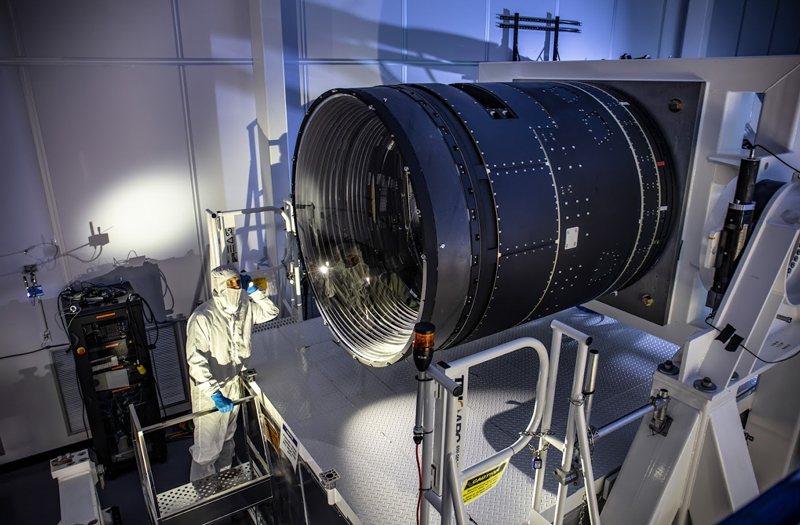On screensaver mode, smart TVs often rotate through photos of natural wonders, from waterfalls to canyons. Now imagine hundreds of those televisions, with one single image spread out among them. The photograph is a sweeping panorama of a huge section of the night sky, with stars and galaxies shining bright throughout. That is the type of image that the newly-completed Legacy Survey of Space and Time (LSST) Camera will take every 20 seconds on clear nights for the course of a decade.
The LSST Camera isn’t designed to just take pretty pictures though. It will offer us new insights into the processes that shaped our universe. The Department of Energy’s (DOE) Office of Science has supported the design, development, and construction of the camera to further our research into dark matter and dark energy.
Despite making up 95 percent of the mass-energy of the universe, scientists don’t have a good handle on what either dark matter or dark energy are.
We haven’t been able to detect dark matter so far. However, like footprints, dark matter leaves imprints on the universe that we can see. In fact, the observatory where the LSST Camera will be installed is named for Vera C. Rubin, an astrophysicist who provided some of the strongest evidence that dark matter exists. While studying how galaxies rotated, she found that they weren’t rotating the way scientists would expect them to for the amount of visible matter in the universe. Using her measurements and other evidence, physicists have calculated that dark matter makes up about five times as much of the universe as ordinary matter. The LSST Camera’s massive power and field of view will provide scientists with a better way to study gravitational lensing. Gravitational lensing happens when huge galaxies bend the light from other galaxies before it reaches us. As a result, the images of the galaxies are slightly distorted. Looking at how the galaxies are distorted allows scientists to analyze how dark matter is distributed across the universe.
Dark energy is the name that scientists have given the mysterious force that is causing the universe to expand ever more quickly. Scientists want to understand how the universe has expanded over time, which can give us clues about why it is expanding now. The images from the LSST Camera will provide more information on this history.
These images will also help scientists investigate how our solar system was formed and gather data on stars in the Milky Way.
The LSST Camera will take these massive images from atop a mountain in Chile. Vera C. Rubin Observatory is on Cerro Pachón, more than 8,900 feet from sea level. From this perch, the LSST Camera will have a tremendous view of the Southern Sky.
The camera is key to the telescope’s success. The size and weight of a small car, it’s the largest camera ever built for astronomy. It’s a hefty 6,000 pounds. In fact, it’s in the Guinness Book of World Records! It’s also the highest resolution camera ever built for astronomy, at a massive 3,200 megapixels. (An average camera for home photography is about 10 to 20 megapixels.) If the scientists wanted it to, the camera could take a clear image of a golf ball about 15 miles away.
The camera has three massive lenses, with the largest one being more than five feet tall. These lenses will open for 15 seconds to take each photo. The camera will then switch to the next image five seconds later. Taking images at this speed requires incredibly precise equipment.
There are also six specialized filters that scientists can switch out in front of the lenses. Instead of making the photos look retro or sparkly, these filters allow scientists to analyze different types of light. The filters can allow the camera to take data on ultraviolet light, near-infrared light, visible light, and more. These different types of light allow scientists to gather different types of data. For example, infrared light isn’t affected by dust, so astrophysicists can use the infrared filter if they are taking photos of objects that space dust would otherwise obscure. The machine can swap out the filters in less than two minutes.
With this technology, the LSST Camera will take photos of more galaxies than there are people on Earth! With its predicted collection of information on 37 billion astronomical objects, it will result in a catalog of data that is thousands of times bigger than any previous one.
This massive camera was the result of two decades worth of work. Led by DOE’s SLAC National Accelerator Laboratory, the team also included DOE’s Brookhaven National Laboratory, DOE’s Lawrence Livermore National Laboratory, and the National Institute of Nuclear and Particle Physics at the National Center for Scientific Research in France. Each contributed essential components, from the digital sensor array to the lenses. As the lead on both building the camera and the DOE’s operations at the Rubin Observatory, scientists at SLAC brought it all together.
With so many literal and metaphorical moving pieces, the project required excellent communication and project management. In fact, the DOE awarded the team with a project management achievement award in 2021.
Now, the team is in the process of moving the LSST Camera to its home in Chile. At SLAC, the engineers, technicians, and scientists are packing it to ship it to another hemisphere. Later this year, a team in Chile will transport it up the Andes Mountains, unpack it, and install it on the telescope.
From there, the camera will open our eyes to a larger view of the universe than we’ve ever had before.
Originally published at https://www.energy.gov/science/articles/largest-digital-camera-ever-built-astronomy-makes-its-debut
The post The Largest Digital Camera Ever Built for Astronomy Makes Its Debut first appeared on Social Gov.

